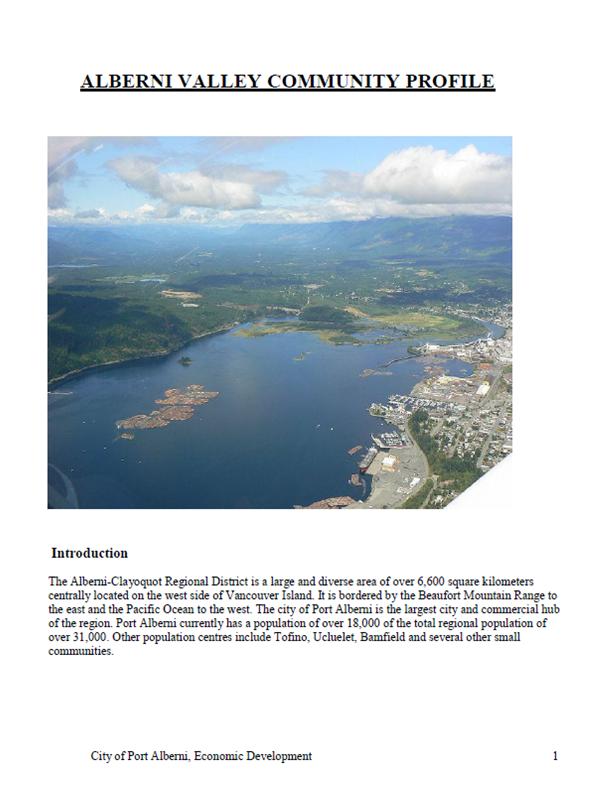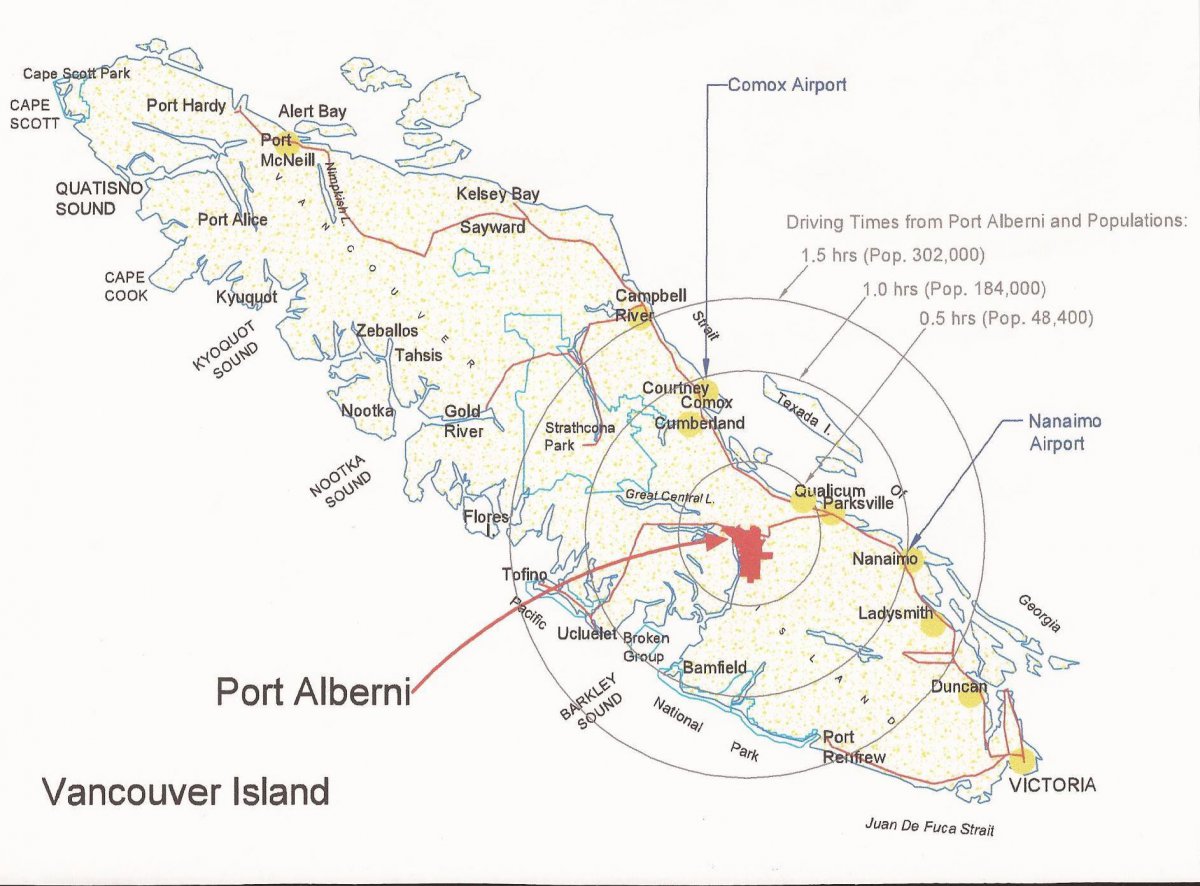
The Alberni-Clayoquot Regional District is a large and diverse area of over 6,600 square kilometers centrally located on the west side of Vancouver Island. It is bordered by the Beaufort Mountain Range to the east and the Pacific Ocean to the west. The city of Port Alberni is the largest city and commercial hub of the region. Port Alberni currently has a population of over 18,000 of the total regional population of over 31,000. Other population centres include Tofino, Ucluelet, Bamfield and several other small communities.
Did you know that?
- The highest vertical drop waterfall in Canada, Della Falls, is located at the western end of Great Central Lake near Port Alberni.
- In 1860, the first sawmill, in what became British Columbia, was constructed In Port Alberni; it began the significant forest industry economic activity in the Alberni Valley which continues to this day
- In 1902, the Bamfield cable station near Port Alberni was constructed as the western terminus of a worldwide undersea telegraph cable.
- The province's first park, Strathcona Provincial Park, was established in 1911 and is located just north of Port Alberni.
- Canada's first female Prime Minister, Kim Campbell, was born in Port Alberni in 1947.
- The world’s largest fire fighting aircraft, the Martin Mars, based just outside Port Alberni at Sproat Lake were put into service in 1959.
- Port Alberni has been designated as the Salmon Capital of the World and the World Fishing Network’s - Ultimate Fishing Town.
- Port Alberni is the shore station for Neptune Canada's 800km electro fibre optic cable.
Back to Top
Profile

 (.PDF) For the entire Alberni Valley Community profile CLICK HERE. Our community profile provides a composite "picture" of our city and surrounding area. The profile highlights our lifestyle, climate, demographics and economic conditions.
(.PDF) For the entire Alberni Valley Community profile CLICK HERE. Our community profile provides a composite "picture" of our city and surrounding area. The profile highlights our lifestyle, climate, demographics and economic conditions.
The City of Port Alberni and the surrounding region thrived for several decades with an economy based on the management and processing of natural resources. The main industries were forestry, commercial fishing, and later tourism provided a more diverse economy.
The manufacture of wood products continues to be the key driver of the local economy, as it has been for several decades. A wide range of products are manufactured either to finished form or shipped elsewhere for further manufacturing and sale. Wood commodities exported range from unprocessed logs, to lumber, to paper to full value-added finishing and artisan products.
The region’s economic backbone continues to be the management of its sustainable resources.
Local oceans are home to plentiful stocks of several species of wild pacific salmon, cod, halibut as well as various shellfish species including clams, oysters, mussels and crabs. Commercial use of these wild fisheries is supplemented with aquaculture farms in certain locations of the region.
The consistent, main driver in this sector is sustainable forest management. Thrifty growing stands of
mixed forests produce a range of products for local use and export. Major commodities currently
exported include: logs, poles, piling, a wide range of lumber products, paper, shakes and shingles.
Relatively small shipments of secondary forest products leaving the valley include: guitar blanks,
mushrooms, berries and florist salal.
Timber resources are held by several different parties including private landowners, First Nations, the
provincial government and the community of Port Alberni.
paper plant, and several sawmills and other wood processing facilities. There are many industrial facilities located in the city provide services to support larger local businesses and to customers outside the communities. Other businesses in the area that might be considered industrial are very diverse, and include the areas of: aviation, marine, trucking, agriculture and aquaculture.
summers providing a relatively long growing season and soil conditions for the production of a variety of
fruits and vegetables. There are currently 7,702 hectares (19,024 acres) of land designated under the
Government of B.C's Agriculture Land Commission as having its best use as agriculture. Of this,
approximately 41% is actively farmed at this time. Over 90% of this is used for livestock production or
feed for the livestock industry.
The Alberni Valley Agriculture Plan (2011-2031) indicates that, there is significant capacity for increased agricultural production in the Alberni Valley. The demand for (and interest in) local food has never been stronger. Consumers want to buy food they trust from people they trust. The Alberni Valley has experienced farmers, with quality soils, climate and capital available to produce more.
Aquaculture operations are located throughout the region. There are many opportunities to continue to
grow this industry in both fin fish and shellfish facilities.
freshwater lakes and streams. This area of Vancouver Island is popular for its salmon sports fishing.
Fishing charters operate year round and the rewards include steelhead, halibut, cod and of course, five species of salmon.
windsurfing, hiking, cycling, golfing, skiing, snowmobiling and wildlife viewing. A long history of support for organized sports, arts and culture, festivals and other entertainment interests are available in the valley and surrounding areas. A system of local parks and a full complement of specific or multiple use facilities are maintained for the public to enjoy.
The area has a full spectrum of health services including a modern regional hospital, intermediate and
extended health care facilities; as well facilities and services for seniors and people requiring special
medical needs. The City of Port Alberni maintains a complete program of essential services. Up-to-date services include fire protection, safety, emergency preparedness, water works, sewage and waste management.
Port Alberni and area has a temperate climate that is influenced by a prevailing western flow that result in periods of extended high levels of precipitation during winter months (November to February), and equally extended periods of dry, warm weather during summer months (May to October). The highest precipitation is typically in January at an average of 309 mm (12 inches) for that month, with the lowest usually in July with a monthly average of only 29 mm (1 inch). Transition periods in Spring and Autumn have weather patterns that are more variable.
Government services and community infrastructures are in place to provide opportunities to enjoy the benefits of the area throughout the year.
The population of the City of Port Alberni and the surrounding communities has been stable for more
than a decade. Ages of the population are generally evenly distributed with the largest proportion in the 45 to 64 age class.
As with much of Vancouver Island, the climate, recreational and leisure opportunities and life style
attracts people from across Canada to retire here. These features along with other family oriented benefits draw younger people to work in local businesses.
The region has a full complement of traditional education opportunities from pre-school, elementary high school college and university.
Pre-school and elementary schools are available throughout communities. A new state-of-the art high school is in place in 2012. Many schools are within walking distance from homes. Dedicated bus services are available to provide transportation to students that live beyond walking distance.
North Island College has a campus located in the City of Port Alberni with a varied curriculum in both trades and academic courses. Certificate, diploma and continuing education programs can be completed in Port Alberni or through the main campus in the Comox Valley. The Justice Institute of British Columbia offers paramedic focuses in conjunction with North Island College.
The Pacific Coast University for Workplace Health Sciences is a post-secondary degree granting education and research institution located in Port Alberni. The facility specializes in workplace safety, health promotion, return to work and disability management, comprehensive rehabilitation and disability leadership studies.
Certificate, diploma and degree programs are provided through Vancouver Island University at Nanaimo. Additional colleges and universities are located on southern Vancouver Island, at Victoria.
While formal education is always encouraged. One of the great strengths of the workforce in the Alberni area is the peoples’ commitment to excellence through skills obtained from previous generations and on-the-job training. A culture of life-long learning and continual improvement continues to contribute to safe and productive teams that provide employers and customers with high quality products.
In the province of British Columbia, taxes and fees are levied by both the provincial government and by the federal government of Canada for various activities including: duties, employment, manufacturing, buying and selling goods and services. The collector of the taxes and fees is governed by the services that are provided by regulatory entities. Structures, administration and fee schedules are provided by the provincial or federal government depending on the appropriate jurisdiction.
There are two sets of local tax assessments in addition to federal and provincial taxes. Both are based on the assessed value of private land and any improvements on that parcel of land. One set of taxes is for land within the city of Port Alberni; the second is for areas outside the city boundaries and are administered by the Regional District of Alberni-Clayoquot.
By having economic development that endeavors to assist existing businesses to be successful while promoting new businesses that provide diversity to the local economy, the City of Port Alberni optimizes the benefits to our citizens. This diversified economy helps to protect the value of existing homeowners from potential tax assessment fluctuations, while providing a level of security that encourages new entrants into the local real estate market.
employers at this time are: Vancouver Island Health Authority, Western Forest Products, School District 70, Catalyst Paper, Wal-Mart, Coulson Group and the City of Port Alberni.
After several decades of relative stability, this area has gone through significant change. People who have worked here have learned to adapt to change to ensure that they can continue to work and live in this beautiful place with so many benefits.
The declines of average income levels are partly the result of changing demographics from the reduced workforce component; as well as the fact that retiring people have discovered the benefits of living in the Alberni area. The change is also the result of reductions in employment levels, particularly in the forest industry, that have included higher paid workers with many years of service. New positions that are coming available with the recovery of the forest industry have allowed newer entrants into the workforce that typically have relatively lower income and benefits.
The vast and healthy forests on coastal British Columbia are being utilized for the many uses of wood fibre and related benefits. The catastrophic damage to the forests to the interior parts of B.C. and other parts of North America by Mountain Pine Beetle does not occur in coastal forests. Scientific advancements and the need for new products from wood fibre provide an opportunity for Port Alberni that has been suggested to exceed anywhere else on the coast. Potential products from forest biomass range from building materials, pharmaceuticals, chemicals to renewable energy.
Some capital investments made over the years have the potential to be revitalized to be more profitable through the introduction of new technologies to infrastructures that are in prime locations but are currently underutilized. Support for new investments is available from several sources within and outside the Port Alberni.
Patrick Deakin
City Hall, 4850 Argyle Street
Port Alberni BC V9Y 1V8













